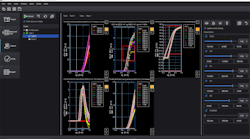What you’ll learn:
- The importance of modeling in semiconductor design.
- Samsung Foundry opts for Keysight’s IC-CAP Model Generator to accelerate the creation of circuit libraries.
Modern manufacturing is becoming more and more complex as designers and manufacturers attempt to integrate the latest core technologies into their solutions. Software design tools are addressing this issue by enabling the modeling of the latest RF fin field-effect transistors (FinFET), a complex and time-consuming process that involves massive amounts of data.
An example of such a tool is Keysight’s IC-CAP Model Generator (MG). It was recently chosen by the Samsung Foundry to give its RF engineers the wherewithal to efficiently organize the large volumes of data needed to develop advanced transistor models.
Faster Simulation
Using the IC-CAP MG software framework, Samsung can handle data management and all of the details involving multi-device simulations. As a result, engineers are able to focus on creating and automating custom flows instead of getting bogged down in the process. Accelerating Samsung's advanced RF semiconductor process technology development, the Python-3-based MG software leverages Keysight's PathWave Device Modeling (IC-CAP) platform.
The solution imports and organizes measured data and circuit netlists for various geometries and temperatures, while automatically creating and simulating RF trend plots of key figures of merit. This data is then used to build custom extraction flows, enabling simulation and real-time tuning of subsystems with complex RF subcircuits, including netlists using layout parasitic-extraction files. The platform features also include model verification and report generation.
Handling Complexity
According to Jongwook Kye, Executive Vice President and Head of Foundry Design Platform Development at Samsung Electronics, "Over the past few years, we have been collaborating closely with Keysight EDA to improve the efficiency and accuracy of our RF modeling flow. By adopting the Model Generator in our workflow, our efficiency has improved by at least 30%. The Model Generator's ability to handle complex netlists and the variety of measured data, including S-parameters and low and high-frequency noise, is critical to us. The flexibility and powerful performance of this tool helps improve the accuracy of models. We can customize the parameters thanks to Python and adapt the Model Generator to our needs."
Niels Faché, Vice President and General Manager, Keysight EDA added, "The modeling of today's RF FinFET and tomorrow's innovative devices is hugely complex and time-consuming. Engineers must extract hundreds of parameters to accurately model the RF behavior of devices for different sizes and temperatures. The Model Generator removes critical barriers in the workflow and allows Samsung engineers to focus more on the modeling and less on the programming. We are pleased that this new solution helps Samsung better manage their modeling workflow, shorten process design kit development cycles, and accelerate product time-to-market."

